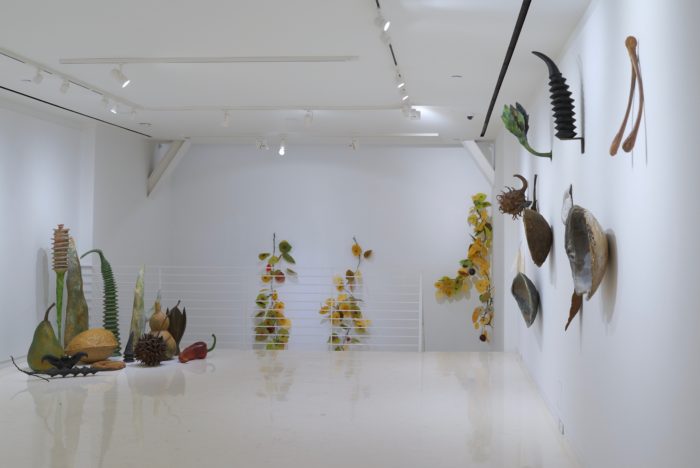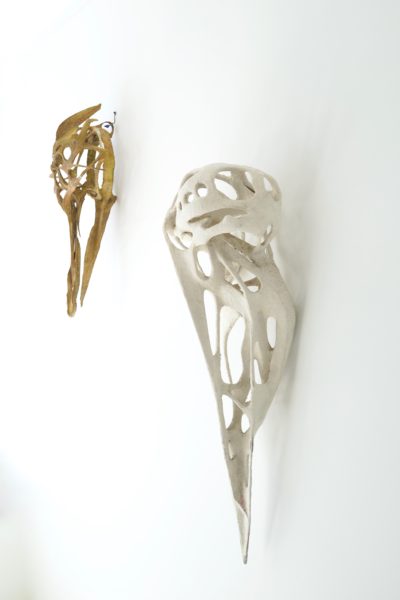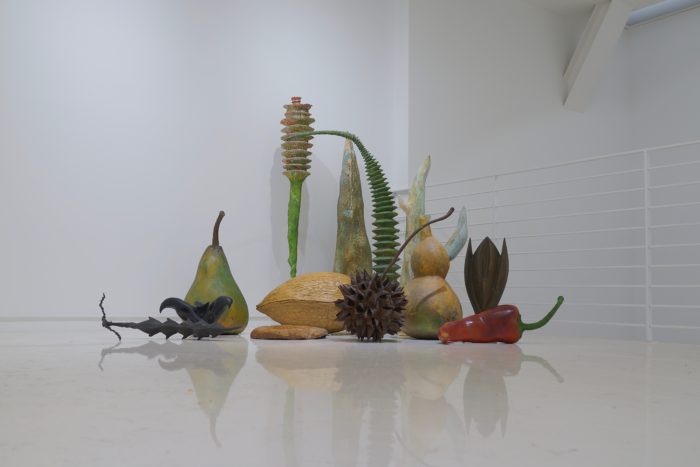
Fay, now in his mid-70s, is retired from active duty as a sculptor. That is our loss. For many years, he quietly made highly interesting sculptural works, almost always based on nature. Originally from Shanghai, he has been in America for half a century, most of that time in New York. His work shifts from individual natural objects, like seashells and seed pods, to installations such as the marvelous decorative garden he constructed for the gallery space in the Philip Morris building on 42nd Street, when the company was active in contemporary art. His individual sculptures are mostly faithful to nature, but he works decoratively–in the best sense of that word!–as well. The show at Sapar Contemporary, curated by the Asian contemporary art scholar Alexandra Chang, covers work done from the early 1980s through the mid-1990s. Mostly, the exhibition is composed of individual works, hung on the wall, and in one case grouped together on the floor. The works compel interest in two ways–by their fidelity to the forms they originate from, and by being their large size, which makes them sculpturally interesting (almost anything made large takes on interest as sculpture). Ming Fay, some thirty years ago, was making art of high, high caliber, and this show reminds us that part of his problem was timing–because he came so early to the New York, before the decade-long interest in Chinese art in the 1990s, he never got the full recognition he deserves.

In this show, and almost always, Ming Fay stays very focused on nature, transforming things like bird skulls and nautilus shells into sculptures of real interest by re-making them in a much larger size. His work, entitled White Bird Skull (1992) is constructed from steel, epoxy, and paper pulp. It is a convoluted, but accurate piece of work, with the cavities between the white-painted bones taking on as much importance as the bones themselves. A major part of the artist’s achievement has to do with his willingness to remain as accurate as possible in regard to what he makes; his fidelity to nature, which is as close as can be to the real thing, never falls into literalism–in large part because of the strength of his craft. White Spiral Shell (1995), made of painted paper pulp strengthened by wire screen, cuts the shell open, revealing the spiral pattern that the piece consists of. Once again, Ming Fay is being highly truthful to nature, and the enlargement of the shell works because of its construction in truthful, albeit larger than life. The sculptures in the show are individual pieces, but in its totality, the exhibition becomes an installation devoted to the beauty and complexity of nature–something the Chinese have always been interested in when they made paintings or sculptures.

A very early work in the show, Maple Seed (1982), is a bit wider than 39 inches. Made of fiberglass and resin, it too is meant to look exactly like the real thing–and does, even if its dimensions dwarf the actuality of the seed. In a work like this fidelity take on more than visual truthfulness; it establishes an esthetic that is visionary and true to the object it is based on. Chinese art has been truly gifted in the representation of nature, in ways that do not distort nature so much as understand it both in relation to humanity and as a creation not necessarily easily understood by the artists rendering it. Nature is always the precursor of beauty–we re-imagine what we see in highly human terms, but our borrowing is from the world outside us rather than what we feel about that world. The feeling begins with the sighting of the object. An even earlier piece, called Sweet Italian Chili Pepper, from 1981 is 32 inches long. It replicates exactly the vegetable we use in cooking–its red body and green stem. Slightly curved, with folds in the flesh of the pepper, the sculpture compels interest primarily because it is so exactingly truthful. Ming Fay always understood that a close replica would maintain interest by virtue of its balance between verisimilitude and art.

The only thing to be missed in this show is the cumulative power of Ming Fay’s installational gifts. Most works here are distinct from those which hang next to it. This means we don’t have a sense of the artist’s profound gift for organization, in which various items are subsumed within a larger visual context. Doing an installation would have required support beyond the capacity of the gallery. So the show is an introduction–a needed and necessary one–to an artist whose unusual strengths as a realist sculptor really need to be better known. In some ways, the isolation of these works intensifies their decorative effect, but this is not a weakness. Instead, we remember that decoration has been a part of Chinese art for a while, in the Ming and Ching Dynasties especially. Ming Fay may or may not be consciously working out of such a tradition, but the extent of his awareness is moot. He is a wonderful Chinese artist, true to his tradition, who has been around for a while, as this excellent show demonstrates.
Ming Fay: Beyond Nature at Sapar Contemporary
April 28 – June 1st, 2019
9 N Moore Street, 1st Floor,
New York, NY 10013

We own a painting of Ming Fay…painted in 1964 when he was a student at the Kansas City Art Institute.
We have no idea of the value of this painting.
Perhaps you can help us.
The painting was a gift to his friend and fellow student, Wes Bradstreet.
Wes is a friend of ours and we bought the painting from Wes several years ago.
Thank you.
Fred Sagarin
fsagarin@gmail.com